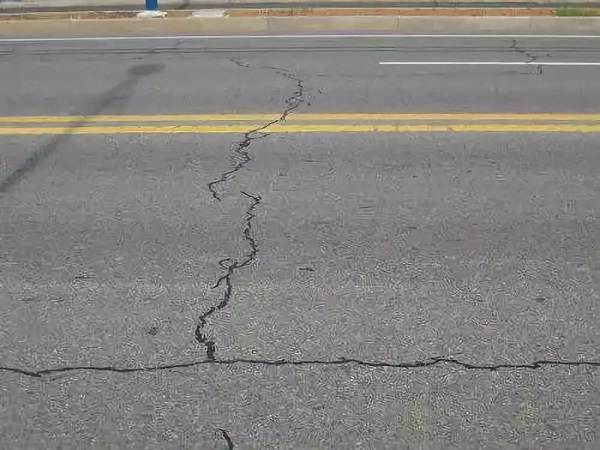Among the early damage phenomena of asphalt concrete pavement, the most frequent pavement diseases are cracks, potholes, subsidence, oil spills, looseness, etc., which lead to poor road conditions, poor pavement flatness and poor skid resistance, seriously affecting the pavement performance.

1. Pavement cracks
Cracks can be divided into transverse cracks, longitudinal cracks and network cracks according to the pavement distribution. The width and density of cracks determine the degree of damage to the pavement and directly affect the service life of the pavement. Due to cracks, water on the pavement seeps into the base layer. Under the repeated action of driving, mud pumping occurs, resulting in structural damage to the pavement base layer, thus destroying the pavement and forming various diseases. One of the main causes of pavement cracks is the influence of the material of asphalt itself, such as high wax content in asphalt, which is easy to age; uneven settlement of the roadbed and insufficient strength of the pavement base layer can also lead to pavement cracks. For example, pavements built on soft soil foundations often have cracks and subsidence.
2. Pavement oil spills, subsidence and poor flatness
(1) Pavement oil spills are mainly due to the influence of the asphalt (oil) stone ratio. The design of the oil-stone ratio only focuses on the indoor Marshall stability control experiment, such as satisfying the three major indicators of flow value, stability, and void ratio to determine the oil-stone ratio, but lacks dynamic stability index experiments to determine the oil-stone ratio and aggregate mix ratio. In order to ensure good adhesion between the pavement interlayers, the construction method of tack coat oil is usually used on the pavement base, but the impact of these tack coat oils on the future oil-stone ratio is often ignored. It is easy to cause the oil-stone ratio to be too large and oil overflow. In addition, since the pavement base is not very flat and there are potholes, and the asphalt layer oil is a flowing liquid, the tack coat oil is often excessively concentrated in low-lying areas, resulting in serious oil overflow on local pavements.
Fast speed and poor flatness are mainly manifested in the influence of density. On the one hand, the subgrade density is not enough, resulting in uneven subsidence of the subgrade, causing local subsidence of the pavement: on the other hand, the pavement base is uneven, the pavement thickness of the mixture is inconsistent, and the compaction is insufficient. As the number of vehicle loads increases. It leads to local subsidence of the pavement. The influence of insufficient aggregate and temperature. Improper mix ratio of oilstone and gravel in the road mixture and insufficient specifications of crushed stone lead to poor road stability. As vehicles load on the road, potholes, oil spills, and bumps appear on the road. High summer temperatures (above 37°C) last for a long time, causing road deformation, are another reason for accelerating the decline in flatness.
(3) In the construction of asphalt concrete pavement, the pavement mixture is inherently insufficient in paving and rolling. The rolling equipment models are not matched and the tonnage is small. The rolling is not timely or in place. The paving temperature of the mixture is too low, which has a great impact on the flatness of the asphalt concrete pavement.
(4) In the construction of asphalt concrete pavement, the poor quality of asphalt, the mixing temperature of the asphalt concrete mixture is too high or too low, the acid-base combination is not good, and the interlayer is seriously polluted, etc., may all lead to loose pavement, potholes, peeling and other diseases.
 Albanian
Albanian  Russian
Russian  Arabic
Arabic  Amharic
Amharic  Azerbaijani
Azerbaijani  Irish
Irish  Estonian
Estonian  Odia (Oriya)
Odia (Oriya)  Basque
Basque  Belarusian
Belarusian  Bulgarian
Bulgarian  Icelandic
Icelandic  Polish
Polish  Bosnian
Bosnian  Persian
Persian  Afrikaans
Afrikaans  Tatar
Tatar  Danish
Danish  German
German  French
French  Filipino
Filipino  Finnish
Finnish  Frisian
Frisian  Khmer
Khmer  Georgian
Georgian  Gujarati
Gujarati  Kazakh
Kazakh  Haitian Creole
Haitian Creole  Korean
Korean  Hausa
Hausa  Dutch
Dutch  Kyrgyz
Kyrgyz  Galician
Galician  Catalan
Catalan  Czech
Czech  Kannada
Kannada  Corsican
Corsican  Croatian
Croatian  Kurdish (Kurmanji)
Kurdish (Kurmanji)  Latin
Latin  Latvian
Latvian  Lao
Lao  Lithuanian
Lithuanian  Luxembourgish
Luxembourgish  Kinyarwanda
Kinyarwanda  Romanian
Romanian  Malagasy
Malagasy  Maltese
Maltese  Marathi
Marathi  Malayalam
Malayalam  Malay
Malay  Macedonian
Macedonian  Maori
Maori  Mongolian
Mongolian  Bengali
Bengali  Myanmar (Burmese)
Myanmar (Burmese)  Hmong
Hmong  Xhosa
Xhosa  Zulu
Zulu  Nepali
Nepali  Norwegian
Norwegian  Punjabi
Punjabi  Portuguese
Portuguese  Pashto
Pashto  Chichewa
Chichewa  Japanese
Japanese  Swedish
Swedish  Samoan
Samoan  Serbian
Serbian  Sesotho
Sesotho  Sinhala
Sinhala  Esperanto
Esperanto  Slovak
Slovak  Slovenian
Slovenian  Swahili
Swahili  Scots Gaelic
Scots Gaelic  Cebuano
Cebuano  Somali
Somali  Tajik
Tajik  Telugu
Telugu  Tamil
Tamil  Thai
Thai  Turkish
Turkish  Turkmen
Turkmen  Welsh
Welsh  Uyghur
Uyghur  Urdu
Urdu  Ukrainian
Ukrainian  Uzbek
Uzbek  Spanish
Spanish  Hebrew
Hebrew  Greek
Greek  Hawaiian
Hawaiian  Sindhi
Sindhi  Hungarian
Hungarian  Shona
Shona  Armenian
Armenian  Igbo
Igbo  Italian
Italian  Yiddish
Yiddish  Hindi
Hindi  Sundanese
Sundanese  Indonesian
Indonesian  Javanese
Javanese  Yoruba
Yoruba  Vietnamese
Vietnamese  Hebrew
Hebrew  Chinese (Simplified)
Chinese (Simplified)






